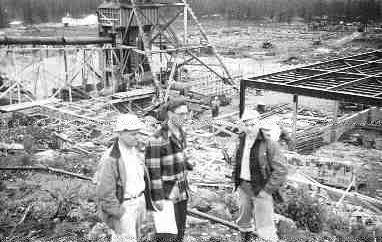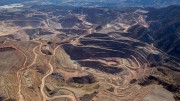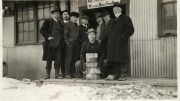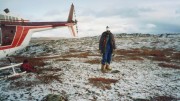The evolution of Elliot Lake, Ont. — from a logging and fur-trapping centre in the early 1900s to the uranium capital of the world in the 1950s and 1960s, and then to its present status as one of most successful retirement communities in Canada — is unique. And few people know that history better than M.E. (Dit) Holt, a mining engineer who began his career by taking part in the staking rush that transformed a remote wilderness north of Lake Huron into a mining boom town.
In the next few months, Holt will bring that history back to life through a series of columns featuring the men (in those days, mining was a man’s game) who found, financed and developed a total of 11 mines in the district.
To set the stage, we’ll go back to 1948, when Aim Breton and Karl Gunterman discovered radioactive rock in Long Twp., east of Blind River. However, significant deposits of the radioactive element were not found, and Breton and Gunterman let their claims lapse. In 1952, prospector Franc Joubin (1911-1997), backed by financier Joseph Hirshhorn (1900-1981), restaked the lapsed claims and set out to determine exactly what was exciting his geiger counter.
Joubin was convinced that the claims covered a uranium orebody, but Hirshhorn was not so confident and refused to put up the $30,000 needed to start drilling. In an effort to win over his grubstaker, Joubin travelled to England to consult with Dr. Charles Davidson, who had worked on uranium found in gold-bearing ores in South Africa. Davidson postulated that when rain water fell, it formed sulphuric acid, which could dissolve uranium mineralization found in association with pyrite. This uranium solution could then be washed deep into the ground; however, a geiger counter would still register radioactivity on the surface. Joubin returned to Canada and talked Hirshhorn into drilling barely a month before the claims were to lapse again. In early May 1953, Joubin and Hirshhorn learned that there was indeed uranium on the Long Twp. claims.
Not one to settle for only one prospect, Joubin began to examine similar geology in the surrounding area; he did so with the aid of a map known as the “Blind River Sheet,” created by William Collins and Pentti Eskola for the Geological Survey of Canada in 1922. From the map, they discovered a “Z” pattern sedimentary contact that covered more than 90 miles in the Elliot Lake region.
Two teams were assembled to investigate. One was headed by Harry Buckles, chief field man for Hirshhorn’s Technical Mine Consultants, and the other was led by Bob Hart, geologist for Preston East Dome, a Hirshhorn-controlled gold mine in Timmins, Ont., of which William Bouck was president.
Buckles was helped by Don Smith and Dit Holt; Hart by Roy Pountney, Manfred Johnson and Frank Horne. These men began a covert staking operation, dubbed the “Backdoor Staking Bee,” which would result in the registering, in July 1953, of 1,400 claims covering 56,000 acres. The word quickly spread, and another 8,000 claims were filed that summer.
Notably, the richest claims fell not to Joubin and Hirshhorn but to Arthur Stollery, a geologist who had worked for Joubin in Long Twp. Stollery staked the downdip extension of the now-famous Quirke Lake deposit, which became the Denison mine. In all, Stollery, with his partners Fred Jowsey and Jim Kenmay, registered 80 claims, which they later sold to Bay Street financier Stephen Roman (1921-1988) for cash and 500,000 shares of Consolidated Denison Mines (Denison would peak at $80 per share).
That same year, Hirshhorn signed a contract with Eldorado Mining & Refining, a Crown company that had an exclusive $1.5-billion contract with the American government to supply the country with uranium oxide for nuclear weapons. The Pronto mine, in Long Twp., near Spragge, was rushed into production, and by 1954, 11 mines were being operated or developed in the Elliot Lake area. Two years later, Hirshhorn would merge his Canadian interests with London-based Rio Tinto to form Rio Tinto Mining Co. of Canada, which would own the Pronto, Pater, Spanish American, Milliken, Quirke, Panel, Nordic, Buckles and Lacnor mines.
In 1955, the government of Ontario created the Improvement District of Elliot Lake, paving the way for its namesake city. Rome wasn’t built in a day, but Elliott Lake almost was. In fact, some say it wasn’t built but beamed into existence at the speed of light. Elliot Lake’s boom times ended in 1959, when the U.S. military announced it would not renew supply contracts with Eldorado. Its population, which peaked at 25,000 in 1960, dropped dramatically in a few years.
The late 1960s again saw a substantial increase in the demand for Elliot Lake uranium, which kept Denison and Rio Algom pulling ore out of the ground. Domestic uses of uranium kept the town alive until the expiry of fixed-price contracts put a halt to mining and the federal government pushed several reclamation projects.
When mining ended, the first priority of community leaders was to save, rather than demolish, more than 3,000 housing units. From this came the goal to establish Elliot Lake as a centre for retirement living. At first the idea sounded far-fetched, even impossible, but the draw of affordable housing worked like a charm, as did the amenities. Numerous outdoor activities — fishing, hunting, boating and sailing, as well as snowmobiling, skiing and golf — offered residents year-round fun. Now, the population sits at about 15,000.
Among other attractions is the Elliot Lake Nuclear and Mining Museum, which opened in 1967. The museum has changed location three times but now rests in its first home — the lower level of the city’s newly renovated Pearson Civic Centre. The Canadian Mining Hall of Fame can be found there (as well as at the University of Toronto), and each year thousands of tourists view the collection of photographs of Canadian mining greats, including the six inductees who helped found and develop Elliot Lake. Fred Mann, the museum’s chairman, who helped bring the hall to Elliot Lake, has also secured several prestigious exhibits, including a portion of the renowned 16,000-piece Pinch mineral collection.
In the coming months, Dit Holt will profile each of the men who made Elliot Lake the uranium capital of the world. Their legacies live on in the streets of the town and in the hearts and minds of those who live there.
His profiles were originally solicited by Cindy Woods, editor of Elliot Lake’s weekly newspaper, The Standard, which also covers the north shore communities.
Next week: Buckles Street.






Be the first to comment on "Odds ‘n’ Sods: The Elliot Lake story"